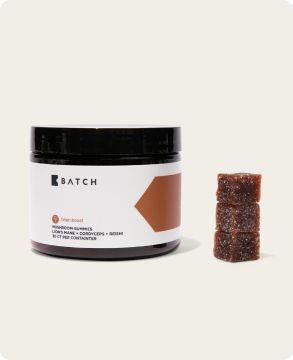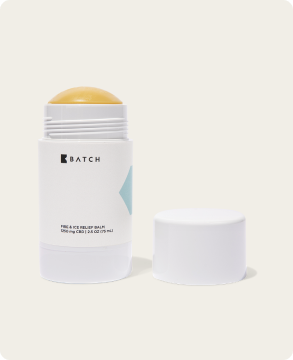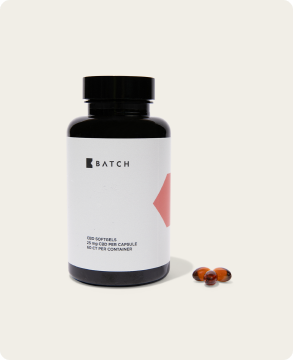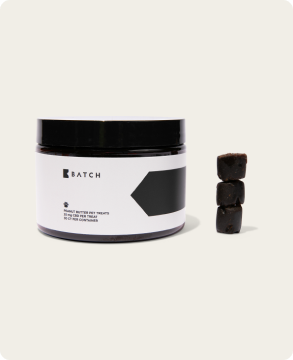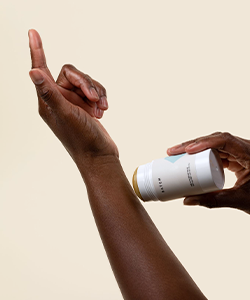THE MOST WONDERFUL GIFT OF THE YEAR
Give The Gift
Of Wellness
Choose gifts that you know they'll love and feel. With a blend for everyone on your list, gift the feeling of relaxation, rest and recovery this holiday season.
SHOP ALL OF BATCHOUR 420 SALE CONTINUES
42% OFF
EXTENDED
In case you missed it yesterday, enjoy 42% off
all one-time purchases of your favorite BATCH products — no code required!*
*Offer available for one-time purchases only. Minimum $25 purchase required and cannot be combined with other coupons. Offer expires 4/21/24 at 11:59pm CDT and cannot be applied to prior purchases.
*Offer expires 3/17/24 at 11:59pm CST and cannot be applied to prior purchases.
The BATCH team at our
hemp farm in Neillsville, WI.
OUR BIGGEST SALE OF THE YEAR
42% OFF
SITEWIDE
Today only, enjoy 42% off all one-time purchases of your favorite BATCH products — no code required!*
SHOP 420 SALE | TODAY ONLY*Offer available for one-time purchases only. Minimum $25 purchase required and cannot be combined with other coupons. Offer expires 4/20/24 at 11:59pm CDT and cannot be applied to prior purchases.
*Offer expires 3/17/24 at 11:59pm CST and cannot be applied to prior purchases.
The BATCH team at our
hemp farm in Neillsville, WI.
FOR 24 HOURS ONLY
Our 420 Sale
Starts Tomorrow
Our biggest sale of the year is almost here! Get notified when our sale goes live tomorrow to ensure you don't miss out on this 24 hour exclusive sale.
GET NOTIFIED FOR 420 SALE*Offer expires 3/17/24 at 11:59pm CST and cannot be applied to prior purchases.
The BATCH team at our
hemp farm in Neillsville, WI.
MEET OUR NEWEST ADDITION
The Foundation
For Your Hydration
Designed to enhance full-body hydration and wellness, our hydration packets contains naturally derived electrolytes
that are sure to give you the
hydration you deserve.
THE MOST WONDERFUL TIME OF THE YEAR
Give The Gift
Of Wellness
Choose gifts that you know they'll love and feel. With a blend for everyone on your list, gift the feeling of relaxation, rest and recovery this holiday season.
SHOP ALL OF BATCHOUR 420 SALE CONTINUES
42% OFF
EXTENDED
In case you missed it yesterday, enjoy 42% off all one-time purchases of your favorite BATCH products — no code required!*
SHOP NOW | TODAY ONLY*Offer available for one-time purchases only. Minimum $25 purchase required and cannot be combined with other coupons. Offer expires 4/21/24 at 11:59pm CDT and cannot be applied to prior purchases.
The BATCH team at our
hemp farm in Neillsville, WI.
OUR BIGGEST SALE OF THE YEAR
42% OFF
SITEWIDE
Today only, enjoy 42% off all one-time purchases of your favorite BATCH products
— no code required!*
*Offer available for one-time purchases only. Minimum $25 purchase required and cannot be combined with other coupons. Offer expires 4/20/24 at 11:59pm CDT and cannot be applied to prior purchases.
The BATCH team at our
hemp farm in Neillsville, WI.
FOR 24 HOURS ONLY
Our 420 Sale
Starts Tomorrow
Our biggest sale of the year is almost here! Get notified when our sale goes live to ensure you don't miss out on this 24 hour exclusive sale.
GET NOTIFIED FOR 420 SALEThe BATCH team at our
hemp farm in Neillsville, WI.
MEET OUR NEWEST ADDITION
The Foundation
For Your Hydration
Designed to enhance full-body hydration and wellness, our hydration packets contains naturally derived electrolytes that are sure to give you the hydration you deserve.
HYDRATE NOWTHE BATCH DIFFERENCE
Created By Science,
Crafted From Nature.
Shop our best-selling products designed to help you
achieve your best rest, recovery, and wellness, naturally.
DOUBLE DOWN ON SLEEP
New! Extra Strength
Nighttime Gummy
Hit snooze on a bad night’s sleep with our brand new
Extra Strength Nighttime Gummy! Double CBD + CBN
helps you fall asleep, stay asleep, and wake up refreshed.
It’s time to get your sleep back on track.
SET YOUR WELLNESS INTO MOTION
Cordyceps & Green Tea
Energy Gummy
Introducing the BATCH Energy Gummy! Formulated
with a blend of cordyceps mushrooms and green tea
derived caffeine, these gummies provide a natural
boost to energize every adventure that life has to offer.
THE BATCH DIFFERENCE
Created By Science,
Crafted From Nature.
Shop our best-selling products designed to help you achieve your best rest, recovery, and wellness, naturally.
SHOP ALL OF BATCHDOUBLE DOWN ON SLEEP
New! Extra Strength Nighttime Gummy
Hit snooze on a bad night’s sleep with our brand new Extra Strength Nighttime Gummy! Double CBD + CBN helps you fall asleep, stay asleep, and wake up refreshed. It’s time to get your sleep back on track.
SHOP EXTRA STRENGTHSET YOUR WELLNESS INTO MOTION
Cordyceps & Green Tea
Energy Gummies
Introducing the BATCH Energy Gummy! Formulated with a blend of cordyceps mushrooms and green tea derived caffeine, these gummies provide a natural boost to energize every adventure that life has to offer.
LEARN MORE
“BATCH is still intimately connected with the local growers it has always relied upon.”

Best CBD Creams of 2021
"[Original Balm] contains lavender and tea tree oils to help relieve irritation."

Ranked #3 for Best CBD Gummies on the Market. “Will leave you feeling your best.”

“Their unbeatable deals, transparency, and commitment to customers is unmatched.”
OUR COLLECTIONS
The Best of BATCH
You won't be disappointed.
OUR COLLECTIONS
The Best of BATCH
You won't be disappointed.
A Blend For Every Occasion
Our all purpose Original Blend was crafted for any occasion. Use it whenever you're not feeling right.
Try Original If...
✓ You're feeling inflamed
✓ You need relief from aches and pains
✓ You want to feel more balanced
A Blend For Every Occasion
Our all purpose Original Blend was crafted for any occasion. Use it whenever you're not feeling right.
Try Original If...
✓ You're feeling inflamed
✓ You need relief from aches and pains
✓ You want to feel more balanced
Crafted By Us, Trusted By You
WE ARE THE MANUFACTURER
From Seed to Doorstep
After years of formulating for other top brands, we knew it was time to create BATCH.
HARVEST + EXTRACTION
Our Wisconsin grown hemp is soaked in ultra cold theanol to extract its therapeutic effects.
FORMULATION + TESTING
This is where the magic happens: our in-house chemists craft effective formulas and test them in-house to ensure quality and potency.
FINISHED GOODS
After all of that, we put the best of BATCH into the bottles and deliver them right to your doorstep.
WE ARE THE MANUFACTURER
From Seed to Doorstep
After years of formulating for dozens of other brands, we knew it was time to give the people what they wanted: the best CBD blends on the market. We’re one of only a few vertically integrated, family owned CBD companies.
HARVEST + EXTRACTION
A quality CBD formula starts with a high quality hemp seed and strain. After the harvest, we soak the rich buds in food grade ethanol to retrieve all of the therapeutic benefits the hemp plant has to offer.
FORMULATION + TESTING
This is where the magic happens. Our in-house chemists craft effective formulas designed for your busy lifestyle and test them in-house to ensure they help you feel better naturally.
FINISHED GOODS
After all of that, we put the best of BATCH into the bottles you know and love. We then deliver them right to your doorstep with careful packaging. This is when we let our CBD do the work!
WE ARE THE MANUFACTURER
From Seed to
Doorstep
After years of formulating for other top brands, we knew it was time to create BATCH.
HARVEST + EXTRACTION
Our Wisconsin grown hemp is soaked in ultra cold ethanol to extract its therapeutic effects.
FORMULATION + TESTING
This is where the magic happens: our in-house chemists craft effective formulas and test them in-house to ensure quality and potency.
FINISHED GOODS
After all of that, we put the best of BATCH into the bottles and deliver them right to your doorstep.
BACKED BY SCIENCE
Our Medical Advisory Board
Our expert advisors consult with our team to ensure premium product quality and safety.
OUR NEWEST ADDITION
Brain Boost Mushroom Gummies
Introducing our latest addition and first ever non-CBD product: a unique blend of functional mushrooms and botanicals specifically formulated to support memory, focus, and brain function.
SHOP BRAIN BOOSTTRY THEM ALL
Sample Our Best Sellers
Take the stress out of deciding and explore our tried & true formulas - all made to fit your pocket and routine.
START SAMPLING
BACKED BY SCIENCE
Our Medical Advisory Board
CBD FOR ALL
Sample our
Best Sellers
Try all of our best-sellers in sample size and find your perfect fit. Made specifically for you & your routine.
START SAMPLINGOUR NEWEST ADDITION
Brain Boost Mushroom Gummies
Meet our first ever non-CBD product: a unique blend of functional mushrooms specifically formulated to support memory, focus, and brain function.
SHOP BRAIN BOOSTBUILD YOUR SAMPLE BUNDLE
Sample Our Best Sellers
Take the stress out of deciding and explore our tried & true formulas - all made to fit your pocket and routine.
START SAMPLING
100% HAPPINESS GUARANTEE
Free returns or exchanges within 30 days to make sure you love your BATCH.
FREE SHIPPING $75+
Get free shipping on all orders $75+. Subscribers automatically receive free shipping without minimums.
HUMAN SUPPORT
Talk with a CBD specialist during our normal business hours, M-F 9 AM - 4 PM CST.
100% HAPPINESS GUARANTEE
Free returns or exchanges within 30 days
to make sure you love your BATCH.
FREE SHIPPING $75+
Get free shipping on all orders $75+. Subscribers automatically receive free shipping without minimums.
HUMAN SUPPORT
Talk with a CBD specialist during our normal
business hours, M-F 9 AM - 4 PM CST.



THE BATCH STORY
Meet The Founders
Feeling you starts with feeling your best. Join our community of people feeling and being their authentic selves.
ABOUT US

THE BATCH STORY
Meet The Founders
Feeling like you starts with feeling your best. Join our community of people feeling and being their authentic selves.
ABOUT US



SUBSCRIBE & SAVE
Become A Gold Member
Our best deal happens all year 'round. Free gifts in every delivery, free shipping, and 25% off every subscription order guaranteed.
LEARN MORESET YOUR WELLNESS ON AUTOPILOT
Become a Gold Member
Our best deal happens all year 'round. But that's just the start our Gold Member perks:
⬩ Pause, cancel, skip anytime
⬩ Limited Edition Free Gifts
⬩ Fast & Free Shipping
⬩ VIP Support
Sign-Up for our monthly newsletter & receive $20 off your first BATCH order.
SET YOUR WELLNESS ON AUTOPILOT
Become A
Gold Member
Our best deal happens all year 'round. Easily Pause, modify, or cancel anytime. But that's just the start our Gold Member perks:
⬩ Limited Edition Free Gifts
⬩ Best price guaranteed
⬩ VIP Support
Fast & Free Shipping On All Subscriptions











